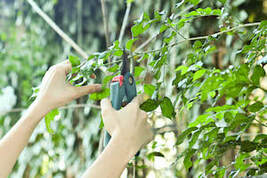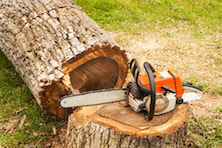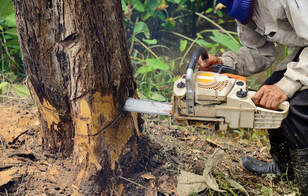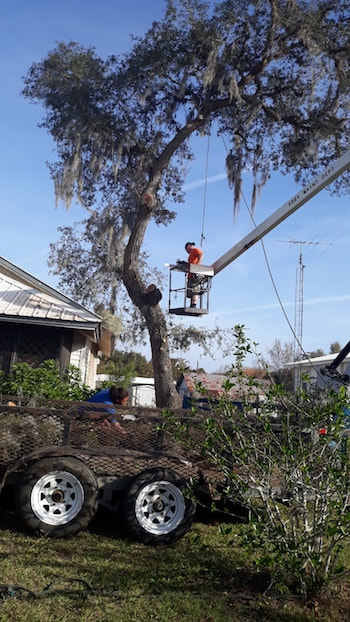Tree removal greatly depends on the tree in question. It will be impossible for a certified arborist to determine the cost of tree removal without seeing the tree with his own eyes. The arborist needs to pay a visit to your property and inspect the tree before he gives you an accurate estimate.
Factors to consider in determining tree removal cost
If the Cost is Too Low, You Might Need to Think Twice and Ask these Questions:
For smaller trees, it is possible to remove them yourself with the right equipment and technique. Keeping your landscape in good condition is a totally different story from maintaining the trees in it. Tree care is more challenging and tedious compared to the former. It would require you to ask assistance from a certified arborist to ensure you're giving the right care your tree needs.
Professional tree service is essential to maintain the overall aesthetic appeal and safety of the trees in your property. Trees that are not trimmed regularly have the potential to overgrow their branches and hang over your property. This can be a recipe for disaster, especially during a storm. Why Trim a Tree Here are other benefits to having your trees regularly pruned:
Trimming a Tree Tree trimming requires skills and equipment to pull off the process successfully. If you haven't done it before and don't have the right tools, it is best to contact an expert to help you. The tree expert will have to navigate around the tree to find the perfect spot before he begins cutting. Arborists consider both the tree and their own safety when performing tree trimming. Needless to say, trimming requires extensive training and discipline to get it done safely and effectively. Be wary of tree companies that use climbing spikes to get up a tree. Climbing spikes are like leather straps attached to the climber's leg to help him navigate through the tree. Although this can make climbing ease for the tree personnel, it puts the tree in danger. It pierces through the delicate tissue on the tree's bark that can cause it to die eventually. Also, the open wounds caused by the spikes can attract pests and disease-causing fungi that can result in the tree's decline. Spikes should only be utilized if the tree is about to be cut down. Trimming a very tall tree Maintaining taller and larger trees is more difficult to fulfill. Nevertheless, it still should be done to prevent accidents. Even older trees need to be pruned regularly so they can thrive even in their old age. There is no doubt that maintaining a tall tree is more complicated, but it is worth it. Neglecting them can cause damage to properties and injuries, which is why you should ask a professional tree service in Tampa to trim them now and then. Looking for a professional tree service company In conclusion, tree maintenance is really challenging and takes up money and time. It is beyond climbing a tree and cutting random limbs and branches. It requires planning and proper execution. To top that, it requires the use of the proper equipment to finish the task successfully. For these reasons, hiring a tree care service is a wiser and a more practical decision than taking on the job yourself. It will save you time, keep you safe, and save you money that you may have to spend for repair and hospital bills if you end up hurting yourself in the process. Removing a tree requires the use of power tools such as a handsaw or a chainsaw. The process of removing a tree should begin with careful planning and follow by proper execution. It will help a lot if you ask someone with experience operating a chainsaw if it's your first time doing it. Make sure to obtain the requirements before getting started.
Prepare to Cut Down the Tree Prepare the area to prevent accidents when the tree falls. Look at where the tree is falling and its surrounding area. Make sure it's far from your house or any fixed structure, including power lines. Get someone experienced in removing a tree to help you in the process. Consider trees as well. Removing a tree may affect other trees, especially ones that are weaker and smaller. Decide What Direction to Fell a Tree It is crucial to find out where the tree is falling to ensure you and your property's safety. If the tree is leaning towards one direction, it is best to fell it in that way. Just make sure there are no structures that will be affected. Getting Away Don't begin sawing until you have removed undergrowth around the tree. Get rid of fallen limbs, branches, and other obstruction in the way. Clearing Tree Limbs and Buttress Roots from a Tree Clear the lower part of the tree of any small branches and buttresses using the chainsaw. You can use a pulling chain to remove branches. At a downward angle, begin cutting from the top. Don't cut limbs that go higher than your shoulders because it is perilous. Directional Felling: How to Fell a Tree in the Right Direction The direction of the tree's fall largely depends on the first few cuts you make or what is called the directional notch. You can make a directional notch in different ways, including the open directional notch. Use these practical steps to make an open directional notch using a chainsaw:
In cutting a large tree, it is vital to use the right cutting technique. If you have a large tree that has a diameter larger than the chainsaw bar, a plunge cut is necessary. A felling wedge and a breaker are some of the tools you will need to safely and successfully cut down a tree.
When it comes to felling a dead or rotten tree, you may need help from expert tree service. It is extra challenging to remove trees of this kind, and you need to practice extra caution. If you see that the trunk is hollow or discolored, it can be an indication of rot in its interior. It is crucial to use a larger hinge to effectively and safely remove rotten and dead trees. Lodged Tree Don't leave the tree that is stuck in another tree without addressing the matter. You should call a professional tree service company right away if the tree lodges in a tree on its way down. You should make the pedestrians aware of the danger by roping the area, then call for help. Learn more.  What is Tree Trimming? Tree trimming is more than cutting away a few branches here and there. It is an essential aspect of tree care and is crucial to your tree's health and aesthetics. Keep in mind that there is a proper approach to trimming and that you should not overdo it. Over trimming can lead to the tree's sudden deterioration. Safety should be the top priority in trimming. Untrimmed trees that grow near power lines can start a fire. Overgrown trees also tend to become an obstruction to pedestrians and drivers alike. Tips
What is Tree Pruning? Tree pruning is as necessary as tree trimming. It is one of the standard methods in tree maintenance. For trees that are planted in a forest, nature usually takes care of pruning these trees. However, the same is not the case for landscape trees. Pruning should be done with a deep understanding of the tree's needs and the right technique to do it. Tips
Conclusion Trimming and pruning are essential for a healthy and well-maintained look of your trees. You will do your trees a favor if you invest in professional tree pruning and trimming because it doesn't only impact their development, but their aesthetics as well. An expert tree service can provide tree care that it exactly needs.  Trees are an essential asset in anyone's property. They don't only make the surrounding more attractive, but they also add privacy as well as provide shade on a hot summer afternoon. But, owning trees in your yard comes with the responsibility of keeping them healthy and in good shape. If there is a dying or a diseased tree in your yard, it is a must that you have it removed immediately before the situation gets out of hand. No matter how simple or complex the task is, when you have a tree that needs to be eliminated, it is best to leave it to the hands of a professional, especially when you are talking about a large tree. Always bear in mind that tree removal is no walk in the park; that is why it is crucial to choose a company that has a good reputation in the tree industry. Remember these following guidelines when considering the right Tampa tree service company for your tree removal project: Go with Experience It should go without saying that you consider hiring a company that has enough years of experience in the field. This is because they would know how to deal with different scenarios in tree removal and has the right credentials to back them up. Although it is not entirely a bad idea to hire a novice company, you don't want to take too much risk. Check their Qualifications Do your homework by making sure you are leaving the job to qualified people. Know what type of equipment and tools they utilize and the technique they use in performing tree removal. Check the Reviews There is no better way to find out about the quality of a company's service but by its previews clients' reviews. There are many websites where you can read honest reviews of customers who have previously used their service. Watch out for recurring negative comments because it must mean something. Read as many reviews as possible so you can make an informed decision as to which company to hire. Ask About Insurance One of the most critical factors you should consider when hiring a tree company is insurance. A reputable company makes sure they are insured for the security of their clients. If the tree removal company doesn't have insurance, and an accident happens, their client may be held liable for both legal and financial responsibility the incident comes with. Insurance should be a non-negotiable when selecting a tree company. Services They Offer When choosing a tree removal company, you also have to consider the services they offer because they are not all the same for all companies. Some companies can't handle stump removal or stump grinding, so it means you will be left with an ugly stump. What would they do with the wood and logs? Will they haul them away or place them into their wood chippers? If the answer to these questions is a resounding "yes," you have come to the right company. These are some of the most important services to look for in a tree removal company. Tree removal is a significant task, and you want to make sure it is done right by the right people. Keep this information in mind when choosing a reliable and trustworthy tree service company in your local area. Are you insured?
Yes, we are. Make a habit of asking your prospective tree service company if they are insured because of the risks involved in doing tree work. We can readily provide you with our insurance documentation along with the contract, so you can review everything before we begin the job. Are you licensed? Definitely. We urge you to never do business with any contractor that doesn't show proof of their license. Most often than not, companies that are not licensed don't have enough skills and the proper equipment to carry out any tree care projects, so be wary of them. Further, insurance providers may invalidate your claims if the tree service is not licensed. Entrust your trees and property to legit professionals who know how to perform tree service safely and efficiently. What do you do with the tree limbs once the service is done? We are pleased to tell you that cleaning up all limbs and debris are included in our estimates, so you don't have to worry about your yard being a mess once we are done. Every time we perform tree service, we make sure to clean our client's yard and leave no trace of tree residue. Some of our customers request us to leave the limbs and do the clean-up on their own to save some cash. But, in most cases, the amount of dirt and wood is too much for the homeowner that's why they leave the job to us. If it happens this way, our customers get billed more than if they had let us clean the debris while on the task of trimming or removing the tree. I have power lines running through my tree. Is that a problem? Absolutely not. We are aware of the dangers involved in working near power lines but our years of experience and training give us confidence that we can perform tree trimming or tree removal safely even with the presence of hazardous situation like this. In rare cases, when we can't work around them, we can call a third party provider to get the power lines out of the way so we can begin the tree work. We can assure you that it won't take long before we can bring the supply of power back in your home. Will there be any damage to my yard? We can give you our word that nothing in your property will be damaged throughout the tree service. However, there are inevitable instances when there may be minor damage to your lawn due to pieces of wood that are produced by tree removal or trimming. Rest assured that we will keep the damage to a minimum and protect your landscaping at all cost. My tree is growing over my house. How will you trim or remove my tree without damaging my roof? When we say we are the best at what we do, we mean it. We have certified arborists and tree technicians who have been trained to do challenging jobs. Our team will carefully plan our action before performing tree work to ensure your property's safety. We use safe approaches and tie off the part of the tree to be cut and ensure it falls in a safe direction. We will slowly lower the portion down and reduce its size even more. Critter Questions: It's typical for us to encounter wildlife when doing tree services and we are aware of the ordinances concerning them. Honeybees: We have crews who specialize in caring for and protecting honeybees. They come to the site and move the hive without added charge. Birds of prey: The simple answer to this question is that we shouldn't get in the way of these species. Squirrels: We do our best not to harm squirrels even as we cut their nests out of the tree. Squirrels always have alternate nests to transfer their babies to. What is the perfect timing to trim my tree? When your purpose for tree trimming is to get rid of dead, dying, or damaged branches, there is no best timing, but as soon as possible. However, there are tree species that benefit from being trimmed during their dormant season. Multi-seed fruit trees such as apple, pear, and mountain ash are ideal to be trimmed in the winter.  If you have ever cut a tree down in your life, you know that it is not a simple job. The truth is, cutting a tree is a dangerous task, and it can cause severe injuries if not done correctly. If you are planning to cut a tree on your own, you should make a careful consideration of the things you need to do before getting the chainsaw and cutting the tree. You don't want to end up on a hospital bed because of negligence and the wrong thought that it is a job that an average guy can do. In this blog, we will discuss important things that you need for cutting a tree. We hope that this can help you cut that tree down correctly and safely. Materials You Need When cutting down a tree, you will need:
Check the Tree to See if it is Out of Your Capacity Before you begin cutting the tree, the first thing you should do is assess the tree and the entire situation and see if it is something within your limits. It is best to know what you are capable and not capable of doing before you start cutting that tree only to leave it unfinished. Remember that not all trees are the same. They should be handled differently, and they need a proper approach to be able to cut them down correctly. One good example is a tree close to a power line, fences, or building. If you see that this is the case for you, it is much better to call a professional tree company to handle tree cutting for you. If you try to do it yourself and it falls in the wrong direction, you will be held financially liable for damaged properties. Also, the lack of proper equipment can make it difficult for you to cut down a tree. If a tree is leaning heavily on one side, chances are it will fall on that side. Having a crane will make the work more comfortable for you, but you may not have it at your disposal that is why in this situation, leave it to the professional. Further, you may also want to check if it is safe for you to climb up the tree. Inspect the tree for dead or broken branches. One wrong step on these branches can cause you injury, so you have to be extra careful. Estimate the Falling Distance Once you are done assessing the tree and you have your safety gears on, the next step is to estimate where the tree will fall. This is a crucial part of the process of cutting down a tree. If a tree falls on you, you will inevitably end up in the hospital, and that's the least we want to happen. Some trees reach a height of more than 200 ft. That is why it can be challenging to tell where it can be falling. To accurately estimate where the tree will fall, you should measure the height of the tree using a crane. Use a tape measure to find out the exact distance of the fall. Another technique is by holding your ax upside down and outstretch your hand. Move back with one eye closed until the ax barely "covers" the sight of the tree. This will help you determine whether the top of the tree will fall in the direction you desire. This is an essential part of making sure you and your property are safe when the tree falls, so we highly recommend you to give it time and effort. You don't want to be surprised that the tree falls exactly on your roof once the process is done. Clear a Separate Escape Route Without the aid of cables and braces, it will be difficult to say where the tree will exactly fall. There are also other natural forces that can make it challenging for you to cut it down. One example is wind. We cannot control where the wind blows, and the wind may cause the tree to fall on the opposite direction of where you originally planned it to take down. If this happens, you should be ready with a plan. Make sure you clear an escape route opposite the direction of where you wanted your tree to fall. This will allow you to have a place to run to in case the tree falls toward you. Safety should always come first; that is why you need to be ready with an alternate path for yourself when the unexpected happens. Cutting down a tree is never an easy task. Even the most professional tree service can still get themselves hurt due to unforeseen situations that is why we encourage you to practice caution when cutting down a tree. |
AuthorTampa Tree Service Archives
February 2024
Categories
All
|


 RSS Feed
RSS Feed